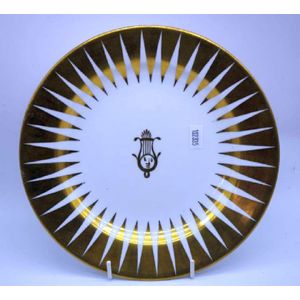Spode Gilded Bone China Plate, c.1820
You must be a subscriber, and be logged in to view price and dealer details.
Subscribe Now to view actual auction price for this item
When you subscribe, you have the option of setting the currency in which to display prices to $Au, $US, $NZ or Stg.
- Gilding - Gilding is a method of ornamentation whereby a thin sheet of gold metal is applied to items made of wood, leather, ceramics, glass and silver for decorative purposes.
For furniture including mirrors, the sheet of gold is usually applied over a coating of gesso. Gesso is a mixture of plaster of Paris and gypsum mixed with water and then applied to the carved wooden frames of mirrors and picture frames as a base for applying the gold leaf. After numerous coats of gesso have been applied, allowed to dry and then sanded a coat of "bole", a usually red coloured mixture of clay and glue is brushed on and allowed to dry, after which the gold leaf is applied. Over time parts of the gilding will rub off so the base colour can be seen. In water gilding, this was generally a blue colour, while in oil gilding, the under layer was often yellow. In Victorian times, gilders frequently used red as a pigment beneath the gold leaf.
Metal was often gilded by a process known as fire gilding. Gold mixed with mercury was applied and heated, causing the mercury to evaporate, the long-term effect of which was to kill or disable the craftsman or woman from mercury poisoning. The pursuit of beauty has claimed many victims, not the least of which were the artists who made those pieces so highly sought after today. - Lyre Motif - The lyre motif is an ancient decorative design that is believed to have originated in ancient Greece, where the lyre was a popular musical instrument. The lyre itself was often decorated with ornate carvings and designs, including the iconic lyre motif.
In ancient Greek mythology, the lyre was associated with the god Apollo, who was the patron of music and the arts. The lyre was said to have been invented by the god Hermes, who presented it to Apollo as a gift. As a result, the lyre became a symbol of creativity, inspiration, and artistic expression.
The lyre motif typically features a curved or S-shaped body, with strings extending upwards from the base. The motif was often used in architectural decoration, as well as on pottery, jewellery, and other decorative objects. - Bone China - Bone china, Also called 'English china", is one of the three types of porcelain, the other two being soft paste porcelain and hard paste porcelain.
Porcelain is an ancient ceramic material, first made in China, hence the common name "china", and the introduction of bone china was to counter the imports of Chinese porcelain.
The initial development of bone china is credited to Josiah Spode, who introduced it around 1800 and it was soon after copied by other manufacturers including Minton, Coalport, Davenport, Derby, Worcester, Wedgwood and Rockingham and the Herculaneum factory at Liverpool.
Spode's bone china was made by mixing ash from cattle bones with feldspar and kaolin, which created a material that was stronger, more translucent, and whiter than traditional porcelain. He began to produce this new type of porcelain in 1796 and it quickly became very popular.
At the time, the process and ingredients were kept secret and were only known to a few manufacturers and were protected by patents.
In the 19th century, bone china became increasingly popular and was widely produced by many manufacturers in England. During this time, it was considered a luxury item and was often used to create fine dining sets and other decorative items.
Bone china is still used in the production of fine porcelain wares, such as tea sets, figurines, and other decorative pieces. His basic formula of six parts bone ash, four parts china stone, and three and a half parts china clay remains the standard English body. It is still considered a luxury item due to its strength, translucency, and whiteness, and is often used for high-end and high-quality porcelain. China.
This item has been included into following indexes:
-
Copeland Spode (England), item types
- plates 181
- plates and platters 224
- Copeland Spode (England), patterns - Regency pattern 88
Visually similar items

'Marguerites' A Lalique frosted and clear glass circular bowl, signed, 33 cm diameter

A large Victorian silver Consular open face pocket watch, hallmarked case Chester 1875. Large Roman numerals, enamel dial. Fusee and chain lever movement by J Johnson Preston. Diameter 60 mm.

Solliet a Paris. A silver and polychrome enamel single hand verge watch French circa 1700, gilt full plate movement signed Solliet a Paris, verge fusee escapement, balance cock applied with a painted enamel miniature of a young 18th century couple in a buc

Le Noir & Fils Rennes. A silver verge watch French circa 1720, gilt full plate movement signed Le Noir & Fils Rennes, verge fusee escapement, decoratively pierced and florally engraved balance cock, Egyptian pillars, white enamel dial with Roman numerals i
